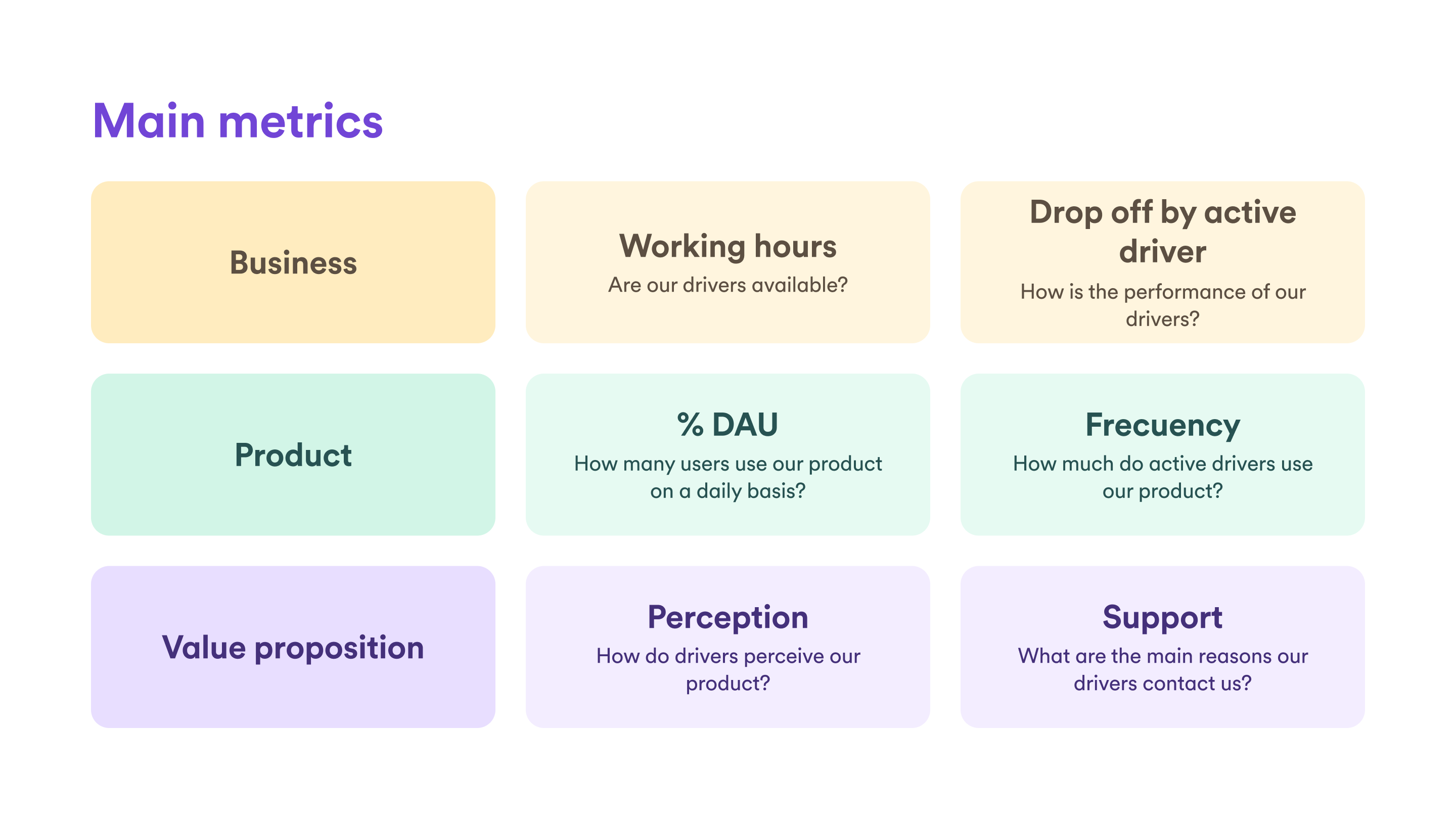Driver engagement
- Driver engagement
About
Driver Engagement is about knowing the needs of our drivers and adapting our products to them. We work on providing our drivers with a complete product that makes them choose us over the competitors. That’s why we are focused on engagement instead of retention. We are not focused on simply bringing drivers back to our app. We are focused on making drivers perceive the interactions with our product as meaningful interactions because they meet their needs, so that drivers can choose to keep performing actions with our product that are significant for them and for us.
We recommend these articles related to engagement vs retention: froged.com, medium.com.
Mission
Our mission is to grow our active drivers base by keeping them with us in a scalable way by building a relationship of loyalty and trust and by empowering them to the decision making so they repeatedly choose Cabify over the competitors.
Vision
Our vision is to be the first ride hailing app choice for drivers.
The team
We consider that we are a multidisciplinary team composed of Tech team (Product, Design, Engineering), Growth, Data Teams (Data Science, DANA), DRM and UR. Also, we understand the driver experience as a whole, with multiple touchpoints that can create engagement, trust and loyalty. That is the reason why we identify, plan and develop initiatives together to make drivers’ interactions with Cabify more meaningful for them. Some of these initiatives are product-based (adding or improving features of the driver app or Durga web), others are enablers that the tech team develops to allow other teams work on their own initiatives, and others are business initiatives.


How do we work
Who is who
Driver engagement is not a small team; rather, it is a team comprised of individuals playing different roles based on their expertise and circumstances.
Engineering ManagerProduct ManagerDesign-
EngineerFrontendAndroidBackend
-
DRI: (Direct Responsible Individuals): They are the feature owners responsible for bringing initiatives to fruition. Typically, this role is assigned to 2 or 3 engineers (at least one for backend and one for frontend). AnEngineertypically fulfills this role. -
OPS: The members assigned to OPS take responsibility for handling issues, bugs, and alerts during the current Sprint. They document and address reports and new alerts, focusing on addressing them rather than working on the main features of the Sprint. AnEngineertypically fills this role.
How do we work
- The DE squad is working with a 2-week sprint dynamic.
- Pair programming is always welcome.
-
We track our work at Shortcut and document our decisions in ADRs.
- We manage incidents and issues based on our Incident Management Process
Ceremonies
Weekly
General team status report, with agenda.
- 0 - Welcoming (~5 min)
- 1 - News and Announcements (~10 min)
- 2 - Ongoing Projects Status (~20m)
- 3 - Incident Updates (~10 min)
-
4 - Q&A (~5 min)
- When: Wednesdays
- Time: 1.00pm (GMT+2)
Alignment
Review current initiatives and check if engineering needs to do the final refinement (aka create the shortcut stories) for something that we will start developing in the next sprint. Does not replace specific meetings about initiatives that the Engineering team should do, along with EM/PM to discuss them.
- Who: Engineering Team + EM
- When: Every two weeks on Thursdays
- Time: 4.30pm (GMT+2)
Planning
This ceremony marks the Sprint kick-off. Here we review previous sprint accomplishments and move forward previous sprint pending issues. We decide on what new things will be included in the sprint, and what needs to be postponed. Before this ceremony, Engineers should have reviewed Epic definitions and extracted stories from them since the Refinement ceremony (previous week’s thursday). PM/EM will express priorities and Engineers issue line-in-the-sand estimations.
- Who: Engineering Team + EM + PM + PD
- When: Every two weeks on Mondays
- Time: 1.00pm (GMT+2)
Retrospective
Review the previous month’s team accomplishments, reflect on what could have been done better and create an action plan to improve the squad.
- Who: Engineering Team + EM + PM + PD
- When: Once a month
- Time: Afternoon (GMT+2)
New initiatives
When we start a new initiative, we follow the next steps:
0. Announcement
Kick-off is declared by the PM announcing the availability of a PID in the weekly meeting.
1. Identification
- DRI: PM and EM will partner to identify the DRI(s) (Directly Responsible Individual/s) for the initiative. The DRI will be in charge of creating the kickoff issue and doing everything.
-
Collaborators: Identify the teams that will collaborate on the initiative.
- Identify other teams’ DRIs.
- Identify other teams’ engineering manager.
2. Planning
-
Driver Engagement internal Slack channel:
- Create an only DE members new Slack channel for the initiative .
- Onboard all collaborators to the channel.
-
Collaboration Slack channel:
- Create a new Slack channel in which include every collaborator outside of DE .
- Onboard all collaborators to the channel.
-
Collaboration sync meeting:
- Schedule a weekly sync meeting with all collaborators.
- Create notes and share them with all collaborators.
3. Kickoff
- Individually in-depth PID review
- Leave comments/questions.
- Fill out
engineering considerationssection.
-
Internal kickoff meeting:
- Schedule a kickoff meeting with DRI, engineering, product and design manager.
- Invitation open to other team members.
Kickoff meeting agenda
- Quick overview of the initiative.
- Phases.
- Doubts.
4. Development
-
Driver Engagement weekly:
- Allocate time in the weekly to provide updates on the initiative.
Finalization
- Archive the Slack channels.
Specific Project Considerations.
DRI will identify them.
For instance:
-
ADR:
- Create an Architecture Decision Record (ADR) for the initiative.
- Share the ADR with all collaborators and discuss.
-
BFF contract:
- Create a document for BFF contracts for the initiative.
- Share it with all collaborators and discuss.
Contact us
Email: product.driver.engagement@cabify.com